Psychology of Drug Addiction: A 12 Step Visit Reaction Paper
VerifiedAdded on 2023/06/14
|9
|2703
|426
AI Summary
This reaction paper discusses the direct and passive effects of drug addiction on individuals, their families, and society. It evaluates the long-term effect of visiting a 12 step group organization for a meeting and discusses strengths and weaknesses of CA, SMART Recovery, and Women for Sobriety.
Contribute Materials
Your contribution can guide someone’s learning journey. Share your
documents today.
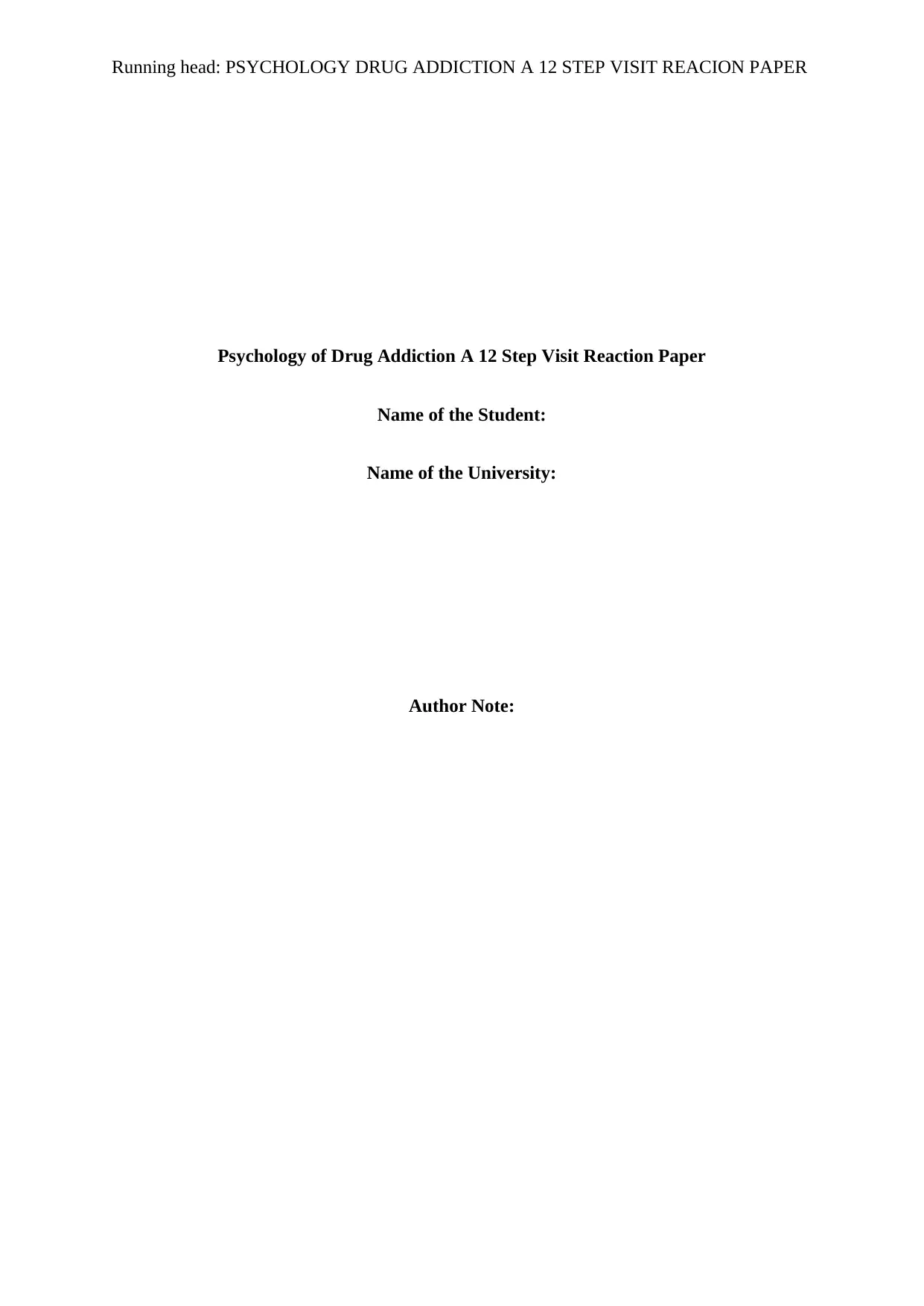
Running head: PSYCHOLOGY DRUG ADDICTION A 12 STEP VISIT REACION PAPER
Psychology of Drug Addiction A 12 Step Visit Reaction Paper
Name of the Student:
Name of the University:
Author Note:
Psychology of Drug Addiction A 12 Step Visit Reaction Paper
Name of the Student:
Name of the University:
Author Note:
Secure Best Marks with AI Grader
Need help grading? Try our AI Grader for instant feedback on your assignments.
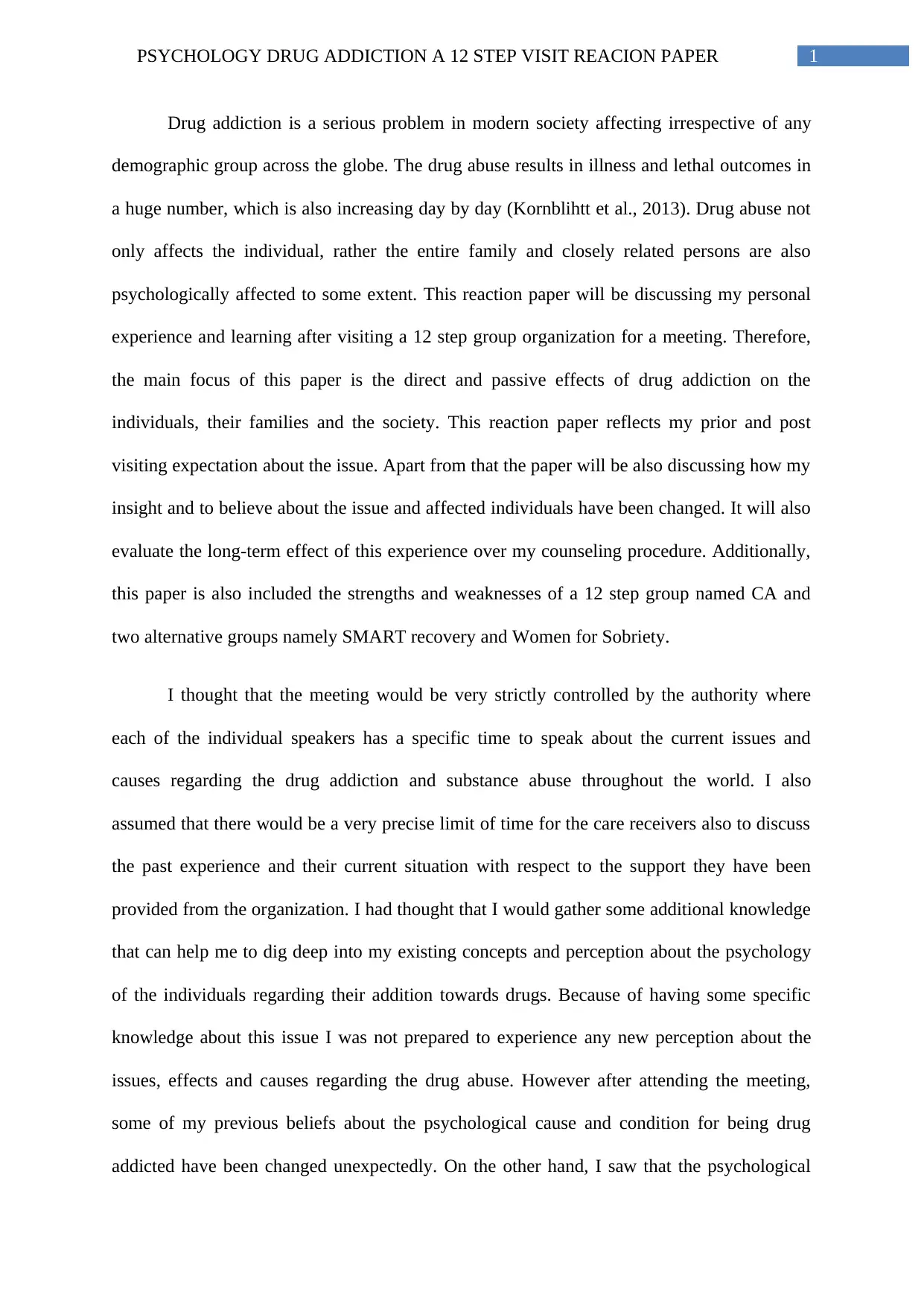
1PSYCHOLOGY DRUG ADDICTION A 12 STEP VISIT REACION PAPER
Drug addiction is a serious problem in modern society affecting irrespective of any
demographic group across the globe. The drug abuse results in illness and lethal outcomes in
a huge number, which is also increasing day by day (Kornblihtt et al., 2013). Drug abuse not
only affects the individual, rather the entire family and closely related persons are also
psychologically affected to some extent. This reaction paper will be discussing my personal
experience and learning after visiting a 12 step group organization for a meeting. Therefore,
the main focus of this paper is the direct and passive effects of drug addiction on the
individuals, their families and the society. This reaction paper reflects my prior and post
visiting expectation about the issue. Apart from that the paper will be also discussing how my
insight and to believe about the issue and affected individuals have been changed. It will also
evaluate the long-term effect of this experience over my counseling procedure. Additionally,
this paper is also included the strengths and weaknesses of a 12 step group named CA and
two alternative groups namely SMART recovery and Women for Sobriety.
I thought that the meeting would be very strictly controlled by the authority where
each of the individual speakers has a specific time to speak about the current issues and
causes regarding the drug addiction and substance abuse throughout the world. I also
assumed that there would be a very precise limit of time for the care receivers also to discuss
the past experience and their current situation with respect to the support they have been
provided from the organization. I had thought that I would gather some additional knowledge
that can help me to dig deep into my existing concepts and perception about the psychology
of the individuals regarding their addition towards drugs. Because of having some specific
knowledge about this issue I was not prepared to experience any new perception about the
issues, effects and causes regarding the drug abuse. However after attending the meeting,
some of my previous beliefs about the psychological cause and condition for being drug
addicted have been changed unexpectedly. On the other hand, I saw that the psychological
Drug addiction is a serious problem in modern society affecting irrespective of any
demographic group across the globe. The drug abuse results in illness and lethal outcomes in
a huge number, which is also increasing day by day (Kornblihtt et al., 2013). Drug abuse not
only affects the individual, rather the entire family and closely related persons are also
psychologically affected to some extent. This reaction paper will be discussing my personal
experience and learning after visiting a 12 step group organization for a meeting. Therefore,
the main focus of this paper is the direct and passive effects of drug addiction on the
individuals, their families and the society. This reaction paper reflects my prior and post
visiting expectation about the issue. Apart from that the paper will be also discussing how my
insight and to believe about the issue and affected individuals have been changed. It will also
evaluate the long-term effect of this experience over my counseling procedure. Additionally,
this paper is also included the strengths and weaknesses of a 12 step group named CA and
two alternative groups namely SMART recovery and Women for Sobriety.
I thought that the meeting would be very strictly controlled by the authority where
each of the individual speakers has a specific time to speak about the current issues and
causes regarding the drug addiction and substance abuse throughout the world. I also
assumed that there would be a very precise limit of time for the care receivers also to discuss
the past experience and their current situation with respect to the support they have been
provided from the organization. I had thought that I would gather some additional knowledge
that can help me to dig deep into my existing concepts and perception about the psychology
of the individuals regarding their addition towards drugs. Because of having some specific
knowledge about this issue I was not prepared to experience any new perception about the
issues, effects and causes regarding the drug abuse. However after attending the meeting,
some of my previous beliefs about the psychological cause and condition for being drug
addicted have been changed unexpectedly. On the other hand, I saw that the psychological
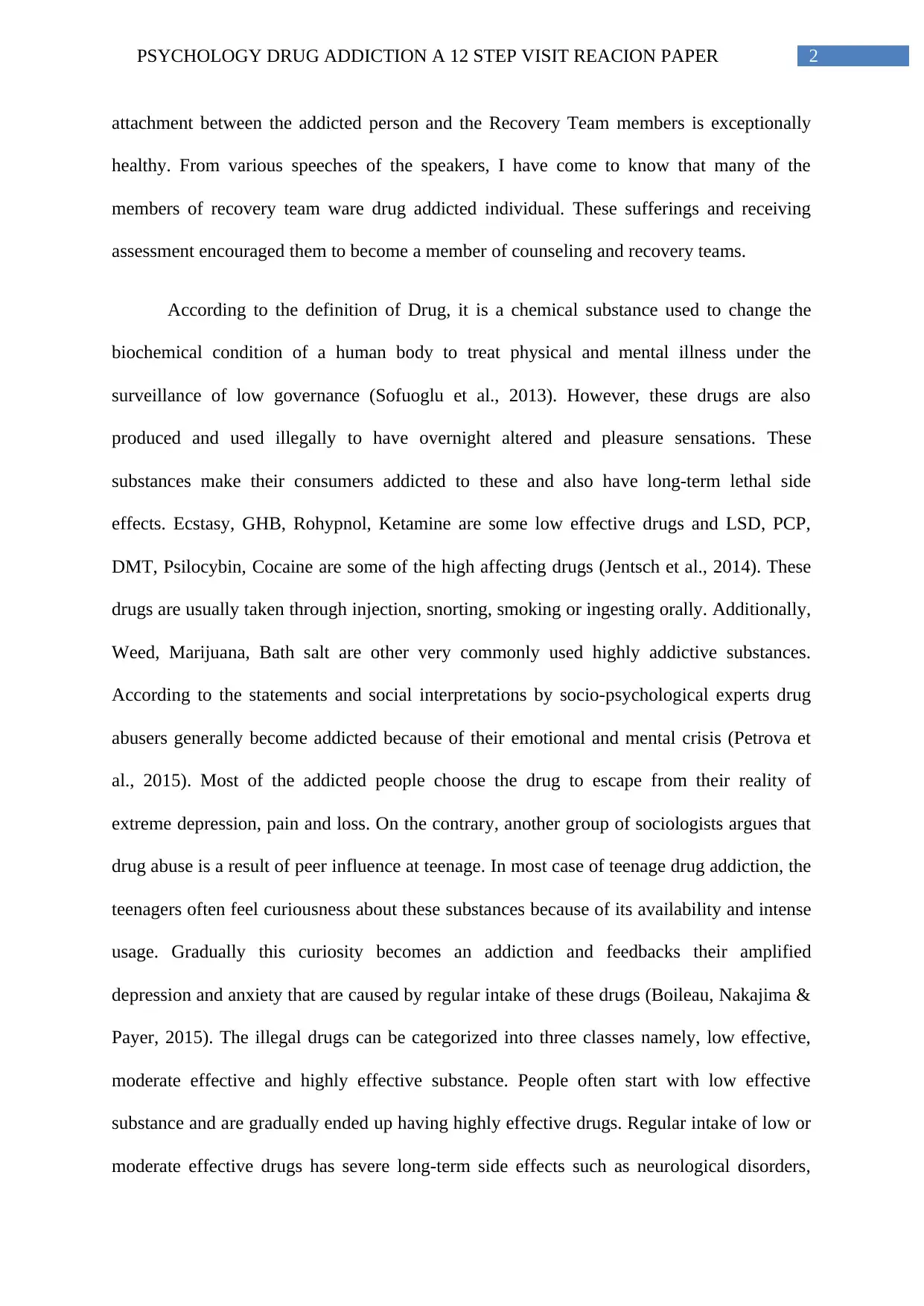
2PSYCHOLOGY DRUG ADDICTION A 12 STEP VISIT REACION PAPER
attachment between the addicted person and the Recovery Team members is exceptionally
healthy. From various speeches of the speakers, I have come to know that many of the
members of recovery team ware drug addicted individual. These sufferings and receiving
assessment encouraged them to become a member of counseling and recovery teams.
According to the definition of Drug, it is a chemical substance used to change the
biochemical condition of a human body to treat physical and mental illness under the
surveillance of low governance (Sofuoglu et al., 2013). However, these drugs are also
produced and used illegally to have overnight altered and pleasure sensations. These
substances make their consumers addicted to these and also have long-term lethal side
effects. Ecstasy, GHB, Rohypnol, Ketamine are some low effective drugs and LSD, PCP,
DMT, Psilocybin, Cocaine are some of the high affecting drugs (Jentsch et al., 2014). These
drugs are usually taken through injection, snorting, smoking or ingesting orally. Additionally,
Weed, Marijuana, Bath salt are other very commonly used highly addictive substances.
According to the statements and social interpretations by socio-psychological experts drug
abusers generally become addicted because of their emotional and mental crisis (Petrova et
al., 2015). Most of the addicted people choose the drug to escape from their reality of
extreme depression, pain and loss. On the contrary, another group of sociologists argues that
drug abuse is a result of peer influence at teenage. In most case of teenage drug addiction, the
teenagers often feel curiousness about these substances because of its availability and intense
usage. Gradually this curiosity becomes an addiction and feedbacks their amplified
depression and anxiety that are caused by regular intake of these drugs (Boileau, Nakajima &
Payer, 2015). The illegal drugs can be categorized into three classes namely, low effective,
moderate effective and highly effective substance. People often start with low effective
substance and are gradually ended up having highly effective drugs. Regular intake of low or
moderate effective drugs has severe long-term side effects such as neurological disorders,
attachment between the addicted person and the Recovery Team members is exceptionally
healthy. From various speeches of the speakers, I have come to know that many of the
members of recovery team ware drug addicted individual. These sufferings and receiving
assessment encouraged them to become a member of counseling and recovery teams.
According to the definition of Drug, it is a chemical substance used to change the
biochemical condition of a human body to treat physical and mental illness under the
surveillance of low governance (Sofuoglu et al., 2013). However, these drugs are also
produced and used illegally to have overnight altered and pleasure sensations. These
substances make their consumers addicted to these and also have long-term lethal side
effects. Ecstasy, GHB, Rohypnol, Ketamine are some low effective drugs and LSD, PCP,
DMT, Psilocybin, Cocaine are some of the high affecting drugs (Jentsch et al., 2014). These
drugs are usually taken through injection, snorting, smoking or ingesting orally. Additionally,
Weed, Marijuana, Bath salt are other very commonly used highly addictive substances.
According to the statements and social interpretations by socio-psychological experts drug
abusers generally become addicted because of their emotional and mental crisis (Petrova et
al., 2015). Most of the addicted people choose the drug to escape from their reality of
extreme depression, pain and loss. On the contrary, another group of sociologists argues that
drug abuse is a result of peer influence at teenage. In most case of teenage drug addiction, the
teenagers often feel curiousness about these substances because of its availability and intense
usage. Gradually this curiosity becomes an addiction and feedbacks their amplified
depression and anxiety that are caused by regular intake of these drugs (Boileau, Nakajima &
Payer, 2015). The illegal drugs can be categorized into three classes namely, low effective,
moderate effective and highly effective substance. People often start with low effective
substance and are gradually ended up having highly effective drugs. Regular intake of low or
moderate effective drugs has severe long-term side effects such as neurological disorders,
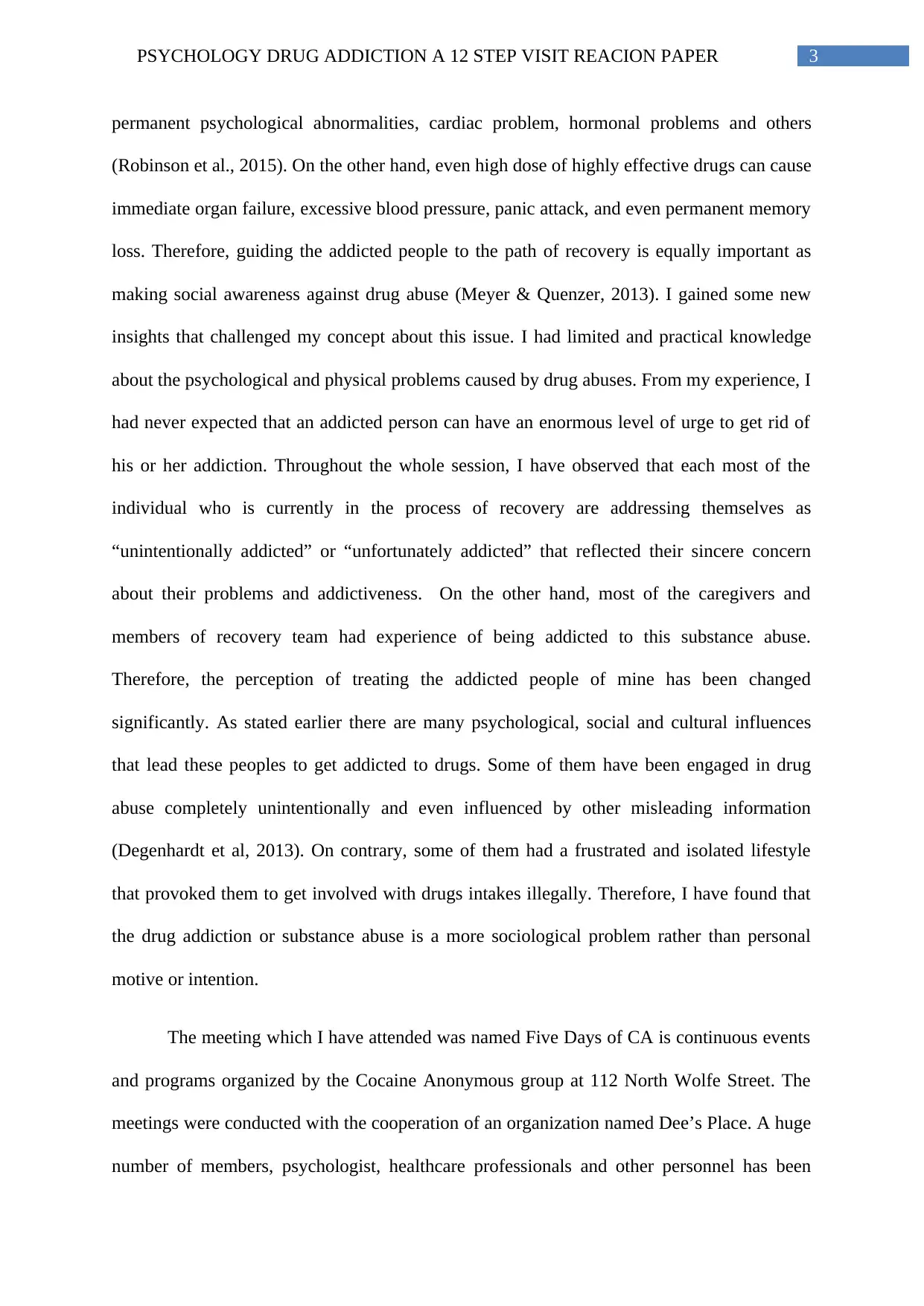
3PSYCHOLOGY DRUG ADDICTION A 12 STEP VISIT REACION PAPER
permanent psychological abnormalities, cardiac problem, hormonal problems and others
(Robinson et al., 2015). On the other hand, even high dose of highly effective drugs can cause
immediate organ failure, excessive blood pressure, panic attack, and even permanent memory
loss. Therefore, guiding the addicted people to the path of recovery is equally important as
making social awareness against drug abuse (Meyer & Quenzer, 2013). I gained some new
insights that challenged my concept about this issue. I had limited and practical knowledge
about the psychological and physical problems caused by drug abuses. From my experience, I
had never expected that an addicted person can have an enormous level of urge to get rid of
his or her addiction. Throughout the whole session, I have observed that each most of the
individual who is currently in the process of recovery are addressing themselves as
“unintentionally addicted” or “unfortunately addicted” that reflected their sincere concern
about their problems and addictiveness. On the other hand, most of the caregivers and
members of recovery team had experience of being addicted to this substance abuse.
Therefore, the perception of treating the addicted people of mine has been changed
significantly. As stated earlier there are many psychological, social and cultural influences
that lead these peoples to get addicted to drugs. Some of them have been engaged in drug
abuse completely unintentionally and even influenced by other misleading information
(Degenhardt et al, 2013). On contrary, some of them had a frustrated and isolated lifestyle
that provoked them to get involved with drugs intakes illegally. Therefore, I have found that
the drug addiction or substance abuse is a more sociological problem rather than personal
motive or intention.
The meeting which I have attended was named Five Days of CA is continuous events
and programs organized by the Cocaine Anonymous group at 112 North Wolfe Street. The
meetings were conducted with the cooperation of an organization named Dee’s Place. A huge
number of members, psychologist, healthcare professionals and other personnel has been
permanent psychological abnormalities, cardiac problem, hormonal problems and others
(Robinson et al., 2015). On the other hand, even high dose of highly effective drugs can cause
immediate organ failure, excessive blood pressure, panic attack, and even permanent memory
loss. Therefore, guiding the addicted people to the path of recovery is equally important as
making social awareness against drug abuse (Meyer & Quenzer, 2013). I gained some new
insights that challenged my concept about this issue. I had limited and practical knowledge
about the psychological and physical problems caused by drug abuses. From my experience, I
had never expected that an addicted person can have an enormous level of urge to get rid of
his or her addiction. Throughout the whole session, I have observed that each most of the
individual who is currently in the process of recovery are addressing themselves as
“unintentionally addicted” or “unfortunately addicted” that reflected their sincere concern
about their problems and addictiveness. On the other hand, most of the caregivers and
members of recovery team had experience of being addicted to this substance abuse.
Therefore, the perception of treating the addicted people of mine has been changed
significantly. As stated earlier there are many psychological, social and cultural influences
that lead these peoples to get addicted to drugs. Some of them have been engaged in drug
abuse completely unintentionally and even influenced by other misleading information
(Degenhardt et al, 2013). On contrary, some of them had a frustrated and isolated lifestyle
that provoked them to get involved with drugs intakes illegally. Therefore, I have found that
the drug addiction or substance abuse is a more sociological problem rather than personal
motive or intention.
The meeting which I have attended was named Five Days of CA is continuous events
and programs organized by the Cocaine Anonymous group at 112 North Wolfe Street. The
meetings were conducted with the cooperation of an organization named Dee’s Place. A huge
number of members, psychologist, healthcare professionals and other personnel has been
Secure Best Marks with AI Grader
Need help grading? Try our AI Grader for instant feedback on your assignments.
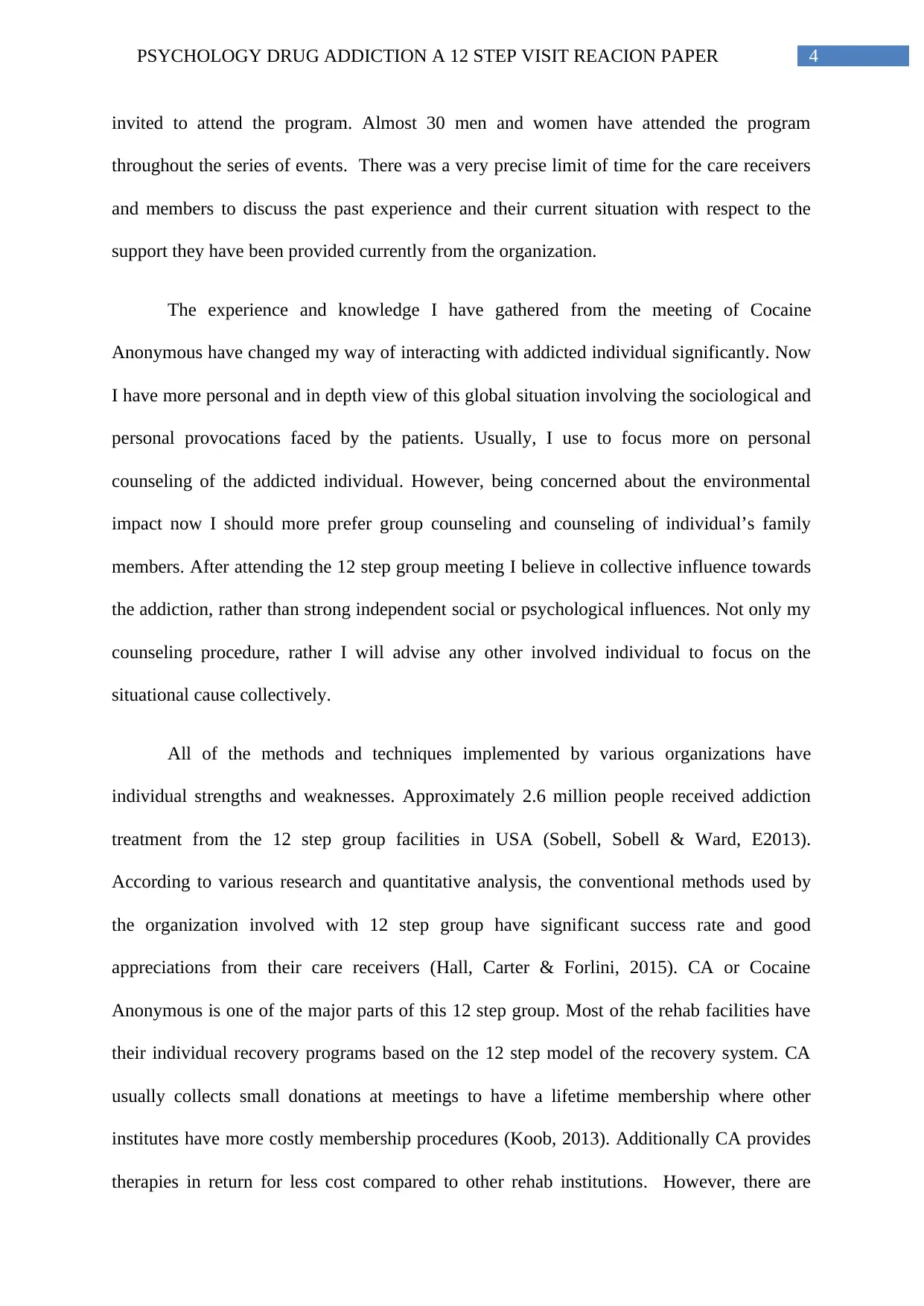
4PSYCHOLOGY DRUG ADDICTION A 12 STEP VISIT REACION PAPER
invited to attend the program. Almost 30 men and women have attended the program
throughout the series of events. There was a very precise limit of time for the care receivers
and members to discuss the past experience and their current situation with respect to the
support they have been provided currently from the organization.
The experience and knowledge I have gathered from the meeting of Cocaine
Anonymous have changed my way of interacting with addicted individual significantly. Now
I have more personal and in depth view of this global situation involving the sociological and
personal provocations faced by the patients. Usually, I use to focus more on personal
counseling of the addicted individual. However, being concerned about the environmental
impact now I should more prefer group counseling and counseling of individual’s family
members. After attending the 12 step group meeting I believe in collective influence towards
the addiction, rather than strong independent social or psychological influences. Not only my
counseling procedure, rather I will advise any other involved individual to focus on the
situational cause collectively.
All of the methods and techniques implemented by various organizations have
individual strengths and weaknesses. Approximately 2.6 million people received addiction
treatment from the 12 step group facilities in USA (Sobell, Sobell & Ward, E2013).
According to various research and quantitative analysis, the conventional methods used by
the organization involved with 12 step group have significant success rate and good
appreciations from their care receivers (Hall, Carter & Forlini, 2015). CA or Cocaine
Anonymous is one of the major parts of this 12 step group. Most of the rehab facilities have
their individual recovery programs based on the 12 step model of the recovery system. CA
usually collects small donations at meetings to have a lifetime membership where other
institutes have more costly membership procedures (Koob, 2013). Additionally CA provides
therapies in return for less cost compared to other rehab institutions. However, there are
invited to attend the program. Almost 30 men and women have attended the program
throughout the series of events. There was a very precise limit of time for the care receivers
and members to discuss the past experience and their current situation with respect to the
support they have been provided currently from the organization.
The experience and knowledge I have gathered from the meeting of Cocaine
Anonymous have changed my way of interacting with addicted individual significantly. Now
I have more personal and in depth view of this global situation involving the sociological and
personal provocations faced by the patients. Usually, I use to focus more on personal
counseling of the addicted individual. However, being concerned about the environmental
impact now I should more prefer group counseling and counseling of individual’s family
members. After attending the 12 step group meeting I believe in collective influence towards
the addiction, rather than strong independent social or psychological influences. Not only my
counseling procedure, rather I will advise any other involved individual to focus on the
situational cause collectively.
All of the methods and techniques implemented by various organizations have
individual strengths and weaknesses. Approximately 2.6 million people received addiction
treatment from the 12 step group facilities in USA (Sobell, Sobell & Ward, E2013).
According to various research and quantitative analysis, the conventional methods used by
the organization involved with 12 step group have significant success rate and good
appreciations from their care receivers (Hall, Carter & Forlini, 2015). CA or Cocaine
Anonymous is one of the major parts of this 12 step group. Most of the rehab facilities have
their individual recovery programs based on the 12 step model of the recovery system. CA
usually collects small donations at meetings to have a lifetime membership where other
institutes have more costly membership procedures (Koob, 2013). Additionally CA provides
therapies in return for less cost compared to other rehab institutions. However, there are
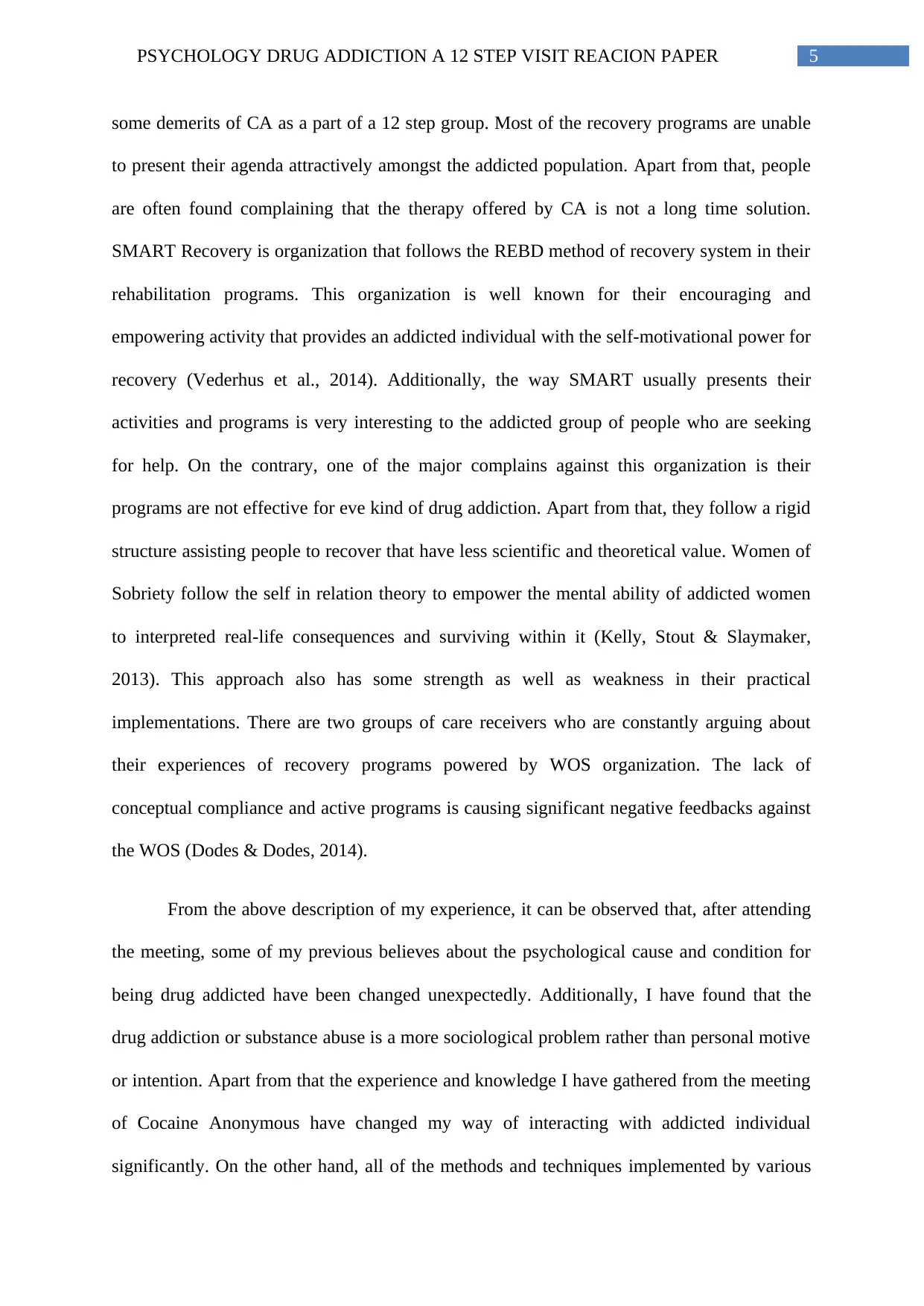
5PSYCHOLOGY DRUG ADDICTION A 12 STEP VISIT REACION PAPER
some demerits of CA as a part of a 12 step group. Most of the recovery programs are unable
to present their agenda attractively amongst the addicted population. Apart from that, people
are often found complaining that the therapy offered by CA is not a long time solution.
SMART Recovery is organization that follows the REBD method of recovery system in their
rehabilitation programs. This organization is well known for their encouraging and
empowering activity that provides an addicted individual with the self-motivational power for
recovery (Vederhus et al., 2014). Additionally, the way SMART usually presents their
activities and programs is very interesting to the addicted group of people who are seeking
for help. On the contrary, one of the major complains against this organization is their
programs are not effective for eve kind of drug addiction. Apart from that, they follow a rigid
structure assisting people to recover that have less scientific and theoretical value. Women of
Sobriety follow the self in relation theory to empower the mental ability of addicted women
to interpreted real-life consequences and surviving within it (Kelly, Stout & Slaymaker,
2013). This approach also has some strength as well as weakness in their practical
implementations. There are two groups of care receivers who are constantly arguing about
their experiences of recovery programs powered by WOS organization. The lack of
conceptual compliance and active programs is causing significant negative feedbacks against
the WOS (Dodes & Dodes, 2014).
From the above description of my experience, it can be observed that, after attending
the meeting, some of my previous believes about the psychological cause and condition for
being drug addicted have been changed unexpectedly. Additionally, I have found that the
drug addiction or substance abuse is a more sociological problem rather than personal motive
or intention. Apart from that the experience and knowledge I have gathered from the meeting
of Cocaine Anonymous have changed my way of interacting with addicted individual
significantly. On the other hand, all of the methods and techniques implemented by various
some demerits of CA as a part of a 12 step group. Most of the recovery programs are unable
to present their agenda attractively amongst the addicted population. Apart from that, people
are often found complaining that the therapy offered by CA is not a long time solution.
SMART Recovery is organization that follows the REBD method of recovery system in their
rehabilitation programs. This organization is well known for their encouraging and
empowering activity that provides an addicted individual with the self-motivational power for
recovery (Vederhus et al., 2014). Additionally, the way SMART usually presents their
activities and programs is very interesting to the addicted group of people who are seeking
for help. On the contrary, one of the major complains against this organization is their
programs are not effective for eve kind of drug addiction. Apart from that, they follow a rigid
structure assisting people to recover that have less scientific and theoretical value. Women of
Sobriety follow the self in relation theory to empower the mental ability of addicted women
to interpreted real-life consequences and surviving within it (Kelly, Stout & Slaymaker,
2013). This approach also has some strength as well as weakness in their practical
implementations. There are two groups of care receivers who are constantly arguing about
their experiences of recovery programs powered by WOS organization. The lack of
conceptual compliance and active programs is causing significant negative feedbacks against
the WOS (Dodes & Dodes, 2014).
From the above description of my experience, it can be observed that, after attending
the meeting, some of my previous believes about the psychological cause and condition for
being drug addicted have been changed unexpectedly. Additionally, I have found that the
drug addiction or substance abuse is a more sociological problem rather than personal motive
or intention. Apart from that the experience and knowledge I have gathered from the meeting
of Cocaine Anonymous have changed my way of interacting with addicted individual
significantly. On the other hand, all of the methods and techniques implemented by various
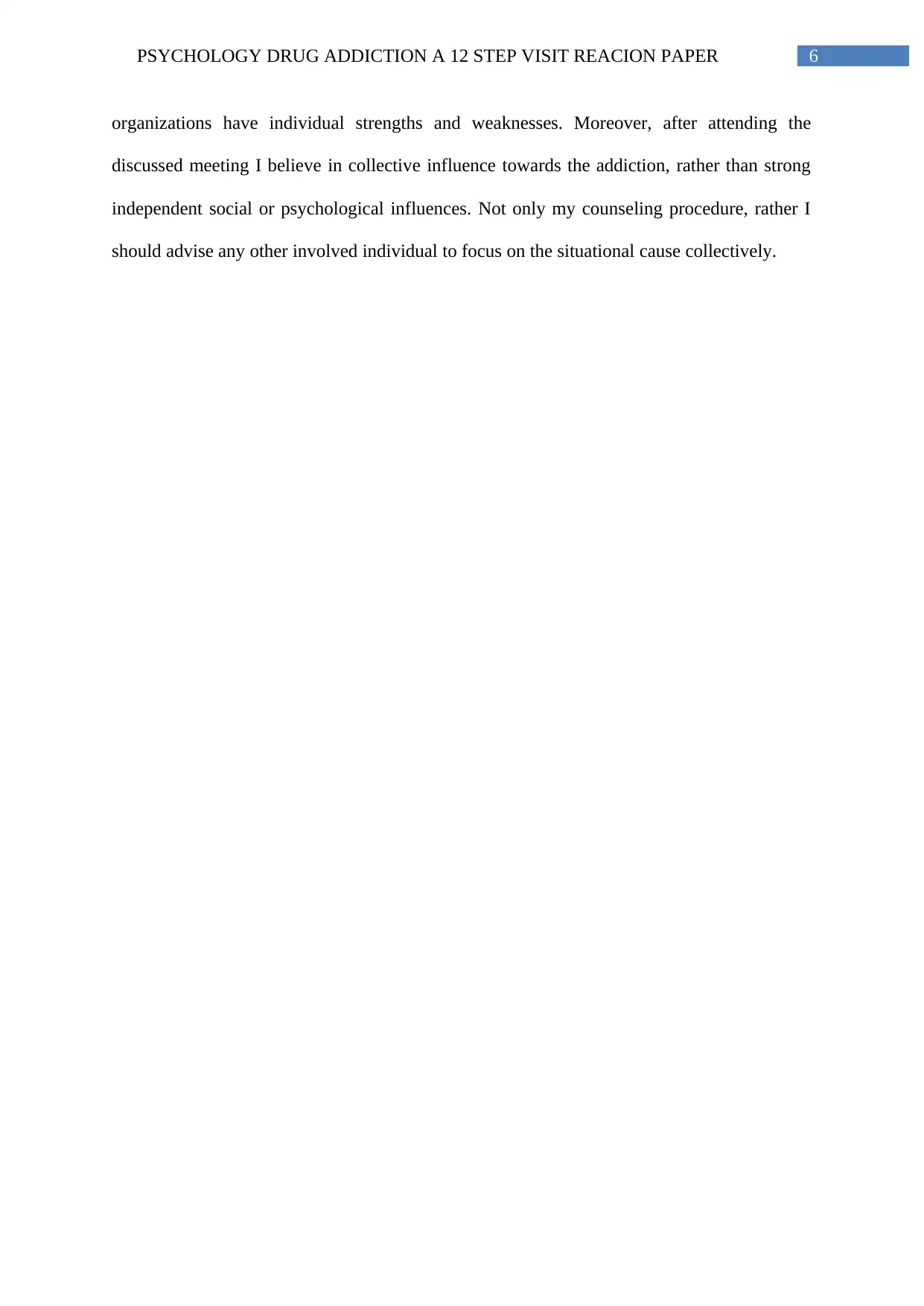
6PSYCHOLOGY DRUG ADDICTION A 12 STEP VISIT REACION PAPER
organizations have individual strengths and weaknesses. Moreover, after attending the
discussed meeting I believe in collective influence towards the addiction, rather than strong
independent social or psychological influences. Not only my counseling procedure, rather I
should advise any other involved individual to focus on the situational cause collectively.
organizations have individual strengths and weaknesses. Moreover, after attending the
discussed meeting I believe in collective influence towards the addiction, rather than strong
independent social or psychological influences. Not only my counseling procedure, rather I
should advise any other involved individual to focus on the situational cause collectively.
Paraphrase This Document
Need a fresh take? Get an instant paraphrase of this document with our AI Paraphraser
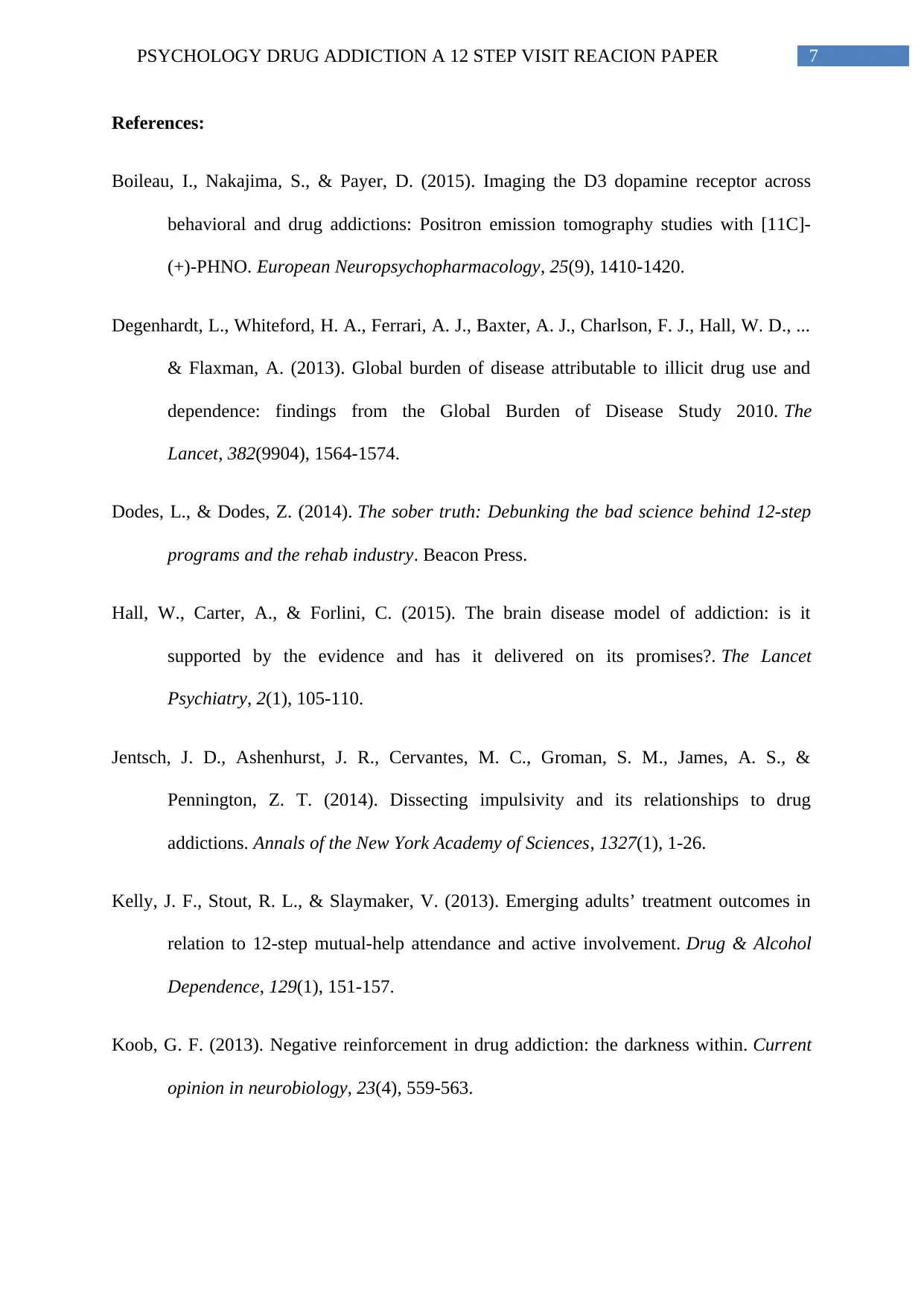
7PSYCHOLOGY DRUG ADDICTION A 12 STEP VISIT REACION PAPER
References:
Boileau, I., Nakajima, S., & Payer, D. (2015). Imaging the D3 dopamine receptor across
behavioral and drug addictions: Positron emission tomography studies with [11C]-
(+)-PHNO. European Neuropsychopharmacology, 25(9), 1410-1420.
Degenhardt, L., Whiteford, H. A., Ferrari, A. J., Baxter, A. J., Charlson, F. J., Hall, W. D., ...
& Flaxman, A. (2013). Global burden of disease attributable to illicit drug use and
dependence: findings from the Global Burden of Disease Study 2010. The
Lancet, 382(9904), 1564-1574.
Dodes, L., & Dodes, Z. (2014). The sober truth: Debunking the bad science behind 12-step
programs and the rehab industry. Beacon Press.
Hall, W., Carter, A., & Forlini, C. (2015). The brain disease model of addiction: is it
supported by the evidence and has it delivered on its promises?. The Lancet
Psychiatry, 2(1), 105-110.
Jentsch, J. D., Ashenhurst, J. R., Cervantes, M. C., Groman, S. M., James, A. S., &
Pennington, Z. T. (2014). Dissecting impulsivity and its relationships to drug
addictions. Annals of the New York Academy of Sciences, 1327(1), 1-26.
Kelly, J. F., Stout, R. L., & Slaymaker, V. (2013). Emerging adults’ treatment outcomes in
relation to 12-step mutual-help attendance and active involvement. Drug & Alcohol
Dependence, 129(1), 151-157.
Koob, G. F. (2013). Negative reinforcement in drug addiction: the darkness within. Current
opinion in neurobiology, 23(4), 559-563.
References:
Boileau, I., Nakajima, S., & Payer, D. (2015). Imaging the D3 dopamine receptor across
behavioral and drug addictions: Positron emission tomography studies with [11C]-
(+)-PHNO. European Neuropsychopharmacology, 25(9), 1410-1420.
Degenhardt, L., Whiteford, H. A., Ferrari, A. J., Baxter, A. J., Charlson, F. J., Hall, W. D., ...
& Flaxman, A. (2013). Global burden of disease attributable to illicit drug use and
dependence: findings from the Global Burden of Disease Study 2010. The
Lancet, 382(9904), 1564-1574.
Dodes, L., & Dodes, Z. (2014). The sober truth: Debunking the bad science behind 12-step
programs and the rehab industry. Beacon Press.
Hall, W., Carter, A., & Forlini, C. (2015). The brain disease model of addiction: is it
supported by the evidence and has it delivered on its promises?. The Lancet
Psychiatry, 2(1), 105-110.
Jentsch, J. D., Ashenhurst, J. R., Cervantes, M. C., Groman, S. M., James, A. S., &
Pennington, Z. T. (2014). Dissecting impulsivity and its relationships to drug
addictions. Annals of the New York Academy of Sciences, 1327(1), 1-26.
Kelly, J. F., Stout, R. L., & Slaymaker, V. (2013). Emerging adults’ treatment outcomes in
relation to 12-step mutual-help attendance and active involvement. Drug & Alcohol
Dependence, 129(1), 151-157.
Koob, G. F. (2013). Negative reinforcement in drug addiction: the darkness within. Current
opinion in neurobiology, 23(4), 559-563.
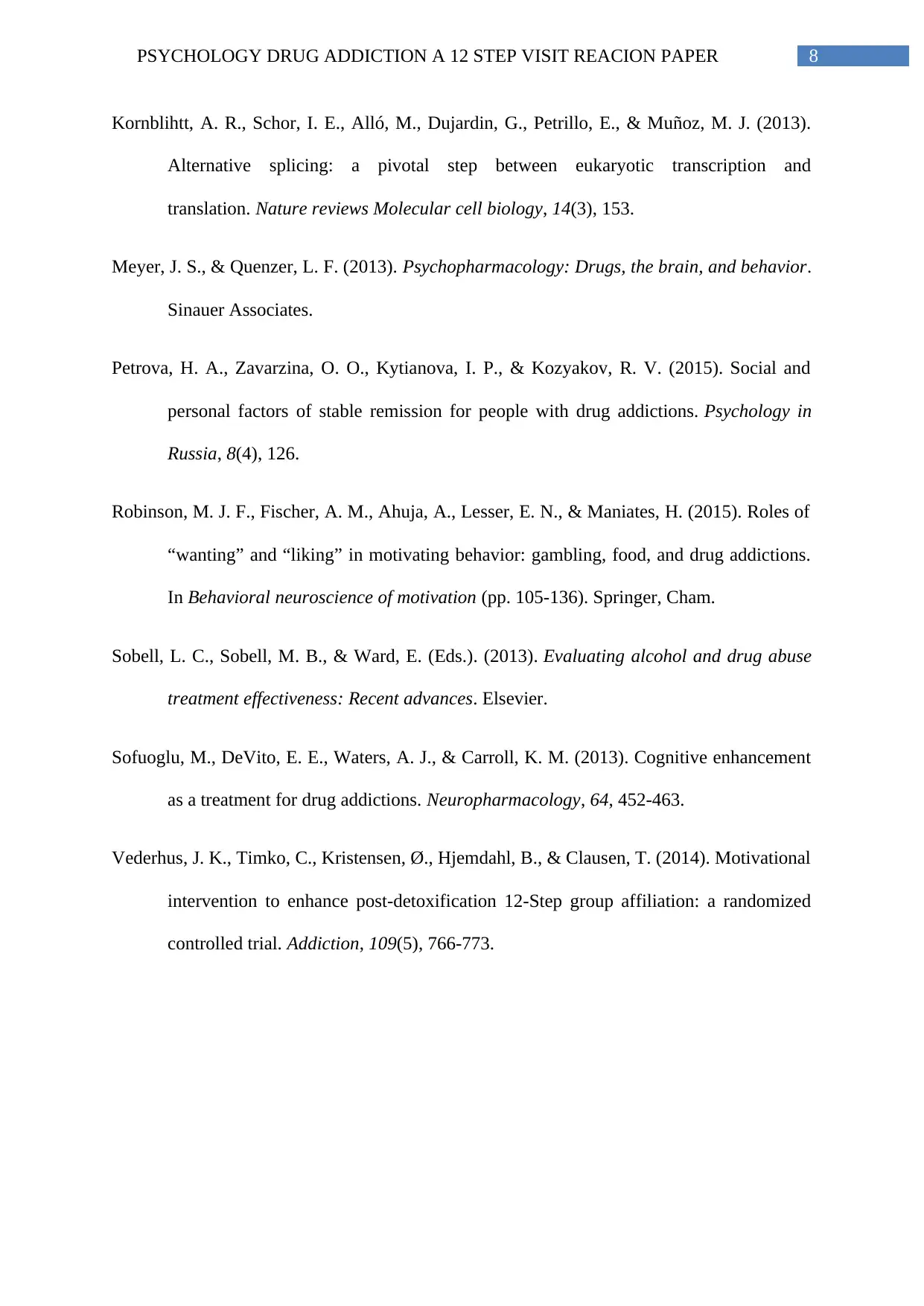
8PSYCHOLOGY DRUG ADDICTION A 12 STEP VISIT REACION PAPER
Kornblihtt, A. R., Schor, I. E., Alló, M., Dujardin, G., Petrillo, E., & Muñoz, M. J. (2013).
Alternative splicing: a pivotal step between eukaryotic transcription and
translation. Nature reviews Molecular cell biology, 14(3), 153.
Meyer, J. S., & Quenzer, L. F. (2013). Psychopharmacology: Drugs, the brain, and behavior.
Sinauer Associates.
Petrova, H. A., Zavarzina, O. O., Kytianova, I. P., & Kozyakov, R. V. (2015). Social and
personal factors of stable remission for people with drug addictions. Psychology in
Russia, 8(4), 126.
Robinson, M. J. F., Fischer, A. M., Ahuja, A., Lesser, E. N., & Maniates, H. (2015). Roles of
“wanting” and “liking” in motivating behavior: gambling, food, and drug addictions.
In Behavioral neuroscience of motivation (pp. 105-136). Springer, Cham.
Sobell, L. C., Sobell, M. B., & Ward, E. (Eds.). (2013). Evaluating alcohol and drug abuse
treatment effectiveness: Recent advances. Elsevier.
Sofuoglu, M., DeVito, E. E., Waters, A. J., & Carroll, K. M. (2013). Cognitive enhancement
as a treatment for drug addictions. Neuropharmacology, 64, 452-463.
Vederhus, J. K., Timko, C., Kristensen, Ø., Hjemdahl, B., & Clausen, T. (2014). Motivational
intervention to enhance post‐detoxification 12‐Step group affiliation: a randomized
controlled trial. Addiction, 109(5), 766-773.
Kornblihtt, A. R., Schor, I. E., Alló, M., Dujardin, G., Petrillo, E., & Muñoz, M. J. (2013).
Alternative splicing: a pivotal step between eukaryotic transcription and
translation. Nature reviews Molecular cell biology, 14(3), 153.
Meyer, J. S., & Quenzer, L. F. (2013). Psychopharmacology: Drugs, the brain, and behavior.
Sinauer Associates.
Petrova, H. A., Zavarzina, O. O., Kytianova, I. P., & Kozyakov, R. V. (2015). Social and
personal factors of stable remission for people with drug addictions. Psychology in
Russia, 8(4), 126.
Robinson, M. J. F., Fischer, A. M., Ahuja, A., Lesser, E. N., & Maniates, H. (2015). Roles of
“wanting” and “liking” in motivating behavior: gambling, food, and drug addictions.
In Behavioral neuroscience of motivation (pp. 105-136). Springer, Cham.
Sobell, L. C., Sobell, M. B., & Ward, E. (Eds.). (2013). Evaluating alcohol and drug abuse
treatment effectiveness: Recent advances. Elsevier.
Sofuoglu, M., DeVito, E. E., Waters, A. J., & Carroll, K. M. (2013). Cognitive enhancement
as a treatment for drug addictions. Neuropharmacology, 64, 452-463.
Vederhus, J. K., Timko, C., Kristensen, Ø., Hjemdahl, B., & Clausen, T. (2014). Motivational
intervention to enhance post‐detoxification 12‐Step group affiliation: a randomized
controlled trial. Addiction, 109(5), 766-773.
1 out of 9
Related Documents
Your All-in-One AI-Powered Toolkit for Academic Success.
+13062052269
info@desklib.com
Available 24*7 on WhatsApp / Email
![[object Object]](/_next/static/media/star-bottom.7253800d.svg)
Unlock your academic potential
© 2024 | Zucol Services PVT LTD | All rights reserved.





